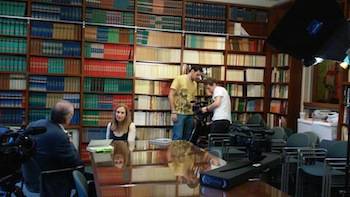Books. Italy’s Skeleton in the Closet
I have heard people refer to “colonial cinema” but there is no other book that mentions “empire cinema.” Why did you choose that term as the title of your book?
Because I wanted to bring attention to the dramatic period from the invasion of Ethiopia in
1935 until the fall of the empire, a period marked by the militarization of society and propaganda. The state supported cinema and spawned this body of work. So I wanted to set it apart from the colonial cinema of the pre-empire period.
Was Mussolini very interested in cinema? Did he have direct control over the directors?
At the beginning of the regime Mussolini was not interested in entertainment movies. He founded the “Istituto Luce” for documentaries and newsreels. Gradually, he realized that this was a mistake.
Was the popularity of foreign films an object of concern to Mussolini? And could this be why he supported the production of empire cinema?
Well, Italians didn’t really want to see Italian films as much as American or even French ones. So, after the invasion of Ethiopia, the Fascist state reorganized the cultural bureaucracy, founded Cinecittà, and gave Istituto Luce a new home to combat American cinema. They took distribution away from American studios. And, in retaliation, American films withdrew from the Italian market. This had a rather ambivalent reception: some worried about not having enough Italian production.
Your book states that 91% of Italian entertainment at that time consisted in going to see movies. So not being able to produce enough was a legitimate concern.
But eventually, during WWII, Italian cinema backed by the state became very successful and was one of the best selling across the axis block. But they had to get rid of American films from Italian screens to achieve that.
In your book you also mention that there are other examples of empire cinema. What would you say is specifically Italian?
There is a lot of foreign influence in these fascist propaganda films. But there are certain things that make them more Italian, like the fact that women are seldom on screen, even when there is a love interest.
The focus is on male bonding, the “military ethos.” Then there are films about emigration, the great drama of early 20th-century Italy, the loss of millions of Italians abroad. Declaring itself an empire gave Italians a chance to leave Brooklyn and Buenos Aires, and come home, not to Italy, where there was no work, but to the colonies.
Which of these films was more surprising or challenging to you?
I would say the two films shot in Somalia, about which nothing is written. One, by Romolo Marcellini, featured real soldiers and very few actors. The other, called Giungla Nera, starred a French actor who made both the Italian and the French versions of the film and a Somali woman. These films are a mix of documentary and fiction with subplots of love and war.
You underline the fact that in empire movies the line between documentary and feature films is blurred.
One of the things I argue in my book is that empire films became a site for experimentation. Because you have to show the colonies, you want to convince people that Italy is making them flourish. So there was a lot of emphasis on getting direct footage, sure, but also on emphasizing the glory of the Italian military by showing real soldiers.
Two generations of important Italian directors worked on these films, including people like Genini, Alessandrini and Cameroni, and also Fellini, Rossellini and Antonioni. But afterward these films were not remembered. Very rarely did directors speak about them, and this cinema was put into the closet.
Finding the material for this book was not easy. For instance, I realized that one of the four storylines of a 1942’s Benghazi had been removed by the Christian Democrats after the war because it featured a prostitute. So I wrote to the archivists at the Museo Nazionale di Torino, and they heroically managed to find a copy of the complete film.





































i-Italy
Facebook
Google+
This work may not be reproduced, in whole or in part, without prior written permission.
Questo lavoro non può essere riprodotto, in tutto o in parte, senza permesso scritto.